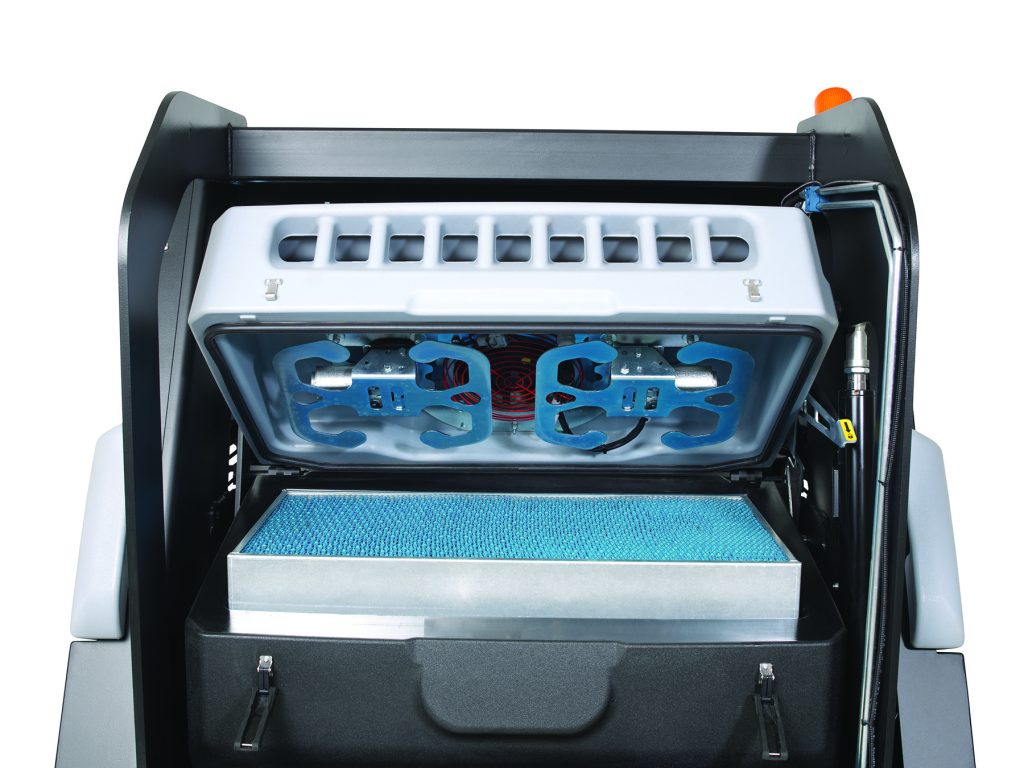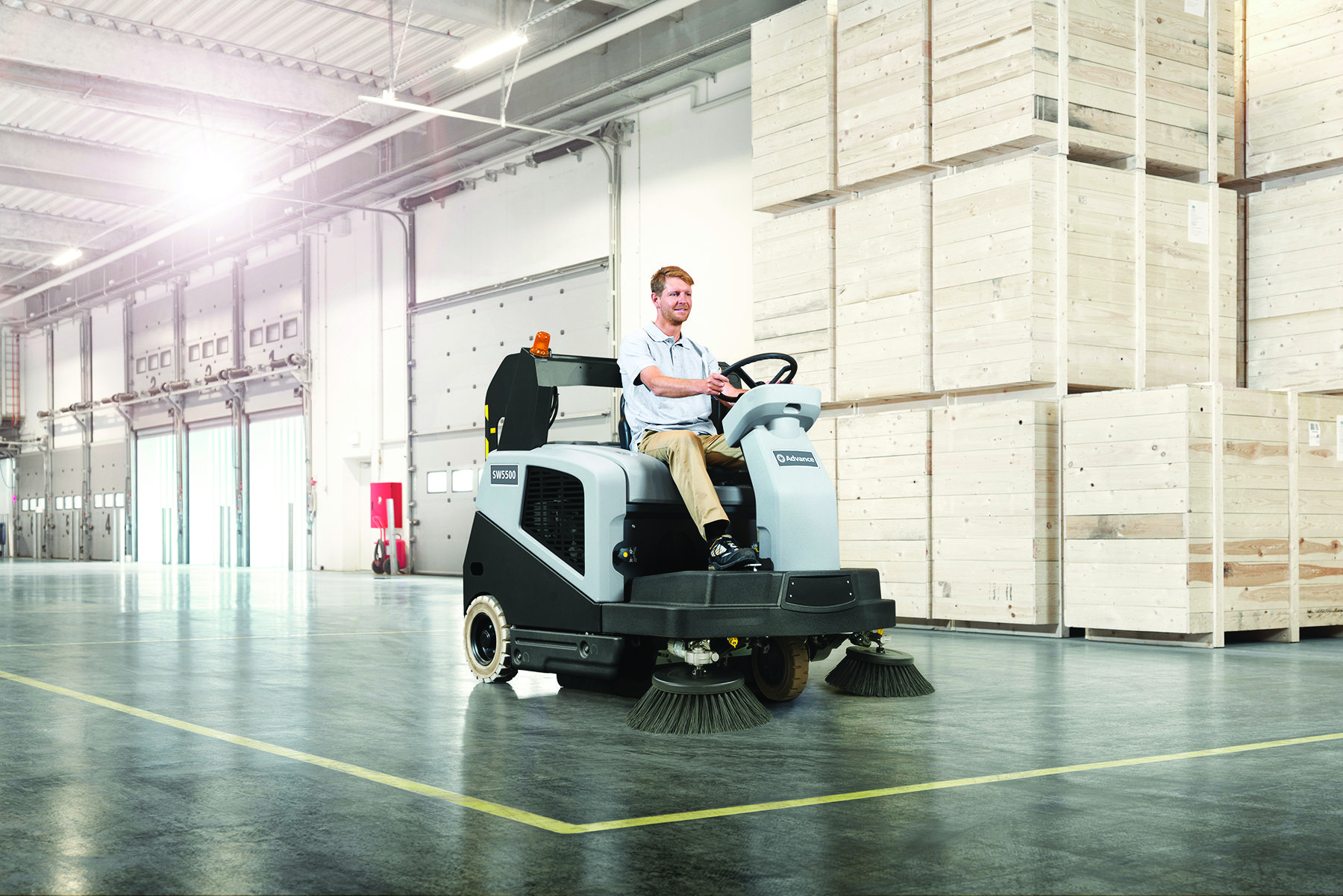Have you recently purchased a floor sweeper machine? Has it been a while since you operated your floor sweeper machine? Properly operating a floor sweeper machine is a simple process, and this article will guide you through it.
Floor sweeper machines come in various sizes and are available in both walk-behind models and ride-on models. This guide will cover the basic steps to operate both model types. Both models follow a similar 7-step process.
- Check the Power Status
- Clean the Debris Hopper
- Clean the Brushes
- Adjust Components
- Turn Power On
- Lower the Side Brush
- Start Sweeping
You should always review the operator manual before using a new floor sweeper machine to ensure you follow all safety and operational requirements.
How to Use a Floor Sweeper in 7 Steps
Walk-behind floor sweepers are typically used for indoor cleaning, especially in small-to-medium sized spaces. They are typically smaller than ride-on models, which makes them easier to navigate in tight spaces.
Ride-on floor sweepers are used for both indoor and outdoor cleaning and work best for medium to large spaces. These models are generally larger and more powerful than walk-behind floor sweepers.
1. Check the Power Status

The first step is to operate a floor sweeper is to check the power status. If the machine is battery-powered, you will want to ensure it has a full charge so you can sweep without it dying in the process.
If your floor sweeper machine is corded, it’s important to ensure the cord is still in working condition. You should never operate a machine with a damaged cord, as this poses a serious safety risk.
In some cases, your ride-on floor sweeper may be powered by another fuel type, such as diesel. Make sure that you have properly fueled the machine.
It’s important to start with a fully powered machine to ensure that you can sweep without the machine stopping in the middle of cleaning.
2. Ensure the Debris Hopper is Clean
Then, you want to ensure the debris hopper on the floor sweeper machine has been cleaned. The debris hopper collects dirt and small debris while cleaning. The debris hopper should be cleaned before the floor sweeper machine is stored after use, but sometimes people forget so it’s good practice to ensure it is clean before sweeping.

It’s important to start sweeping with a clean debris hopper so you can clean it without having to stop to clean it soon after you start. If the debris hopper is too full, the machine will not work properly and it can even cause the machine to overheat and stop working until it is cleaned out.
There are two main types of debris hopper systems: front-loading and rear-loading. To clean the debris hopper, you will need to empty it into a large garbage can. It may need to be emptied directly into a dumpster for larger machines.
In some cases, particularly for larger ride-on floor sweepers, the debris hopper can be emptied automatically by the press of a button. For other machines, the debris hopper can be emptied manually by removing it and dumping the contents.
3. Clean the Brushes
Every floor sweeper has a main brush and one or more side brushes. To ensure the brushes perform optimally, they should be free of debris before you start the sweeper. Ideally, this was completed after the previous use, but you should always double-check before you begin.
Most of the debris from sweeping is collected in the debris hopper. However, some debris, such as strings, can get caught up in the bristles. You can pull the debris free with your fingers to clean it out. Never attempt to clean the brushes when the floor sweeper machine is on to prevent injuries from moving parts.
4. Adjust Components
It’s important to ensure the brushes are adjusted properly. If the floor sweeper machine applies too much pressure or too little, it will not sweep properly and can leave behind dust and dirt. Using too much pressure can also damage the bristles and reduce the brush’s life.
For some floor sweeper machines, the brushes have specific adjustment settings depending on the type of sweep you intend to do. For example, a flat floor might be on setting one, while an uneven one might be on setting five. Your manual can help you determine the most appropriate setting for the floor you are sweeping.

If your floor sweeper machine doesn’t have specific settings, a good rule of thumb is having the bristles clear a 1” to 2” mark while stationary. If the mark is less, adjust the brush down, and if the mark is more, bring the brush up.
You should also adjust the push handle to a comfortable height. The right handle height is based entirely around your height and posture. Typically, a comfortable height is right around hip level.
5. Turn the Power On
Now, you can turn the power on. Sometimes, the floor sweeper machine is turned on with a button. You may also have a key, which is more common for ride-on floor sweepers.
In some cases, you may need to allow the machine to warm up by sitting idle for a few minutes before operating.
6. Lower the Side Brush
Now that the machine is one, you should lower the side brush. The side brush is typically raised when the floor sweeper machine is not in use. This is to prevent accidental damage during storage. It also makes cleaning the brush easier.

For the side brush to function, you’ll need to lower it to the floor. When the machine is in operation, the side brush will push debris in front of the floor sweeper to be swept up by the main brush.
7. Start Sweeping
When sweeping, you should always start against the wall to the right of the floor sweeper machine. As you move forward, clean in a counterclockwise direction to get the best effect from the side brush.
While sweeping, periodically use the shaker to clear debris off the filter. Depending on the size of your debris hopper and the amount of debris, you may need to clean the debris hopper out periodically while you sweep.
After you are finished using the floor sweeper machine, you’ll want to prepare the machine for storage.
How to Properly Store a Floor Sweeper
The floor sweeper machine should always be cleaned before storage. This means emptying the debris hopper and cleaning any debris from the brushes.
You should also raise any side brushes on the floor sweeper to prevent accidental damage during storage.
It’s also essential to clean the filters. You may want to use a vacuum to thoroughly clean between all the fins in the filter.
If your machine runs on battery power, make sure it’s plugged in to charge for the next use. For corded machines, ensure that the cords are properly stored to prevent damage and to make sure that they are not a tripping hazard.
For floor sweeper machines that run on fuel, you may need to take additional measures to safely store them. Your manual will guide you through the proper safety storage procedures.
When storing your floor sweeper machine, make sure there is adequate room. Small, cramped spaces can lead to damage from other items being stacked on or falling on top of the machine. It can also be a safety hazard for your staff.
You will also want a space that is cool and dry. Exposure to high heat, extreme cold, and moisture can damage the electronics in the machines.
Final Thoughts
If you want additional training on how to use a floor sweeper, reach out to one of our experts at Imperial Dade.
We can even help with a product demonstration to see which floor sweeper is best suited for your facility’s needs.